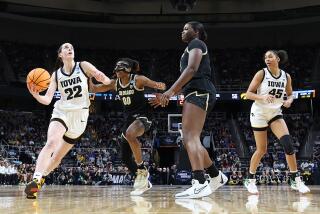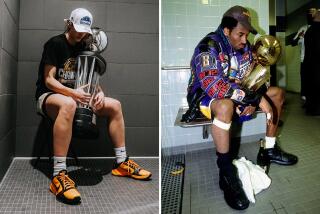Book Review: ‘Wonder Girl: The Magnificent Sporting Life of Babe Didrikson Zaharias’
Wonder Girl
The Magnificent Sporting Life of Babe Didrikson Zaharias
Don Van Natta Jr.
Little, Brown: 404 pp., $27.99
So do you know who made the Top 10 when ESPN chose its 50 Greatest Athletes of the 20th Century? Here they are: (1) Michael Jordan. (2) Babe Ruth. (3) Muhammad Ali. (4) Jim Brown. (5) Wayne Gretzky. (6) Jesse Owens. (7) Jim Thorpe. (8) Willie Mays. (9) Jack Nicklaus. (10) Babe Didrikson Zaharias.
So do you know what this means? It means the Babe — the female one as well as the male — was a greater athlete than Joe Louis, Carl Lewis, Wilt Chamberlain, Magic Johnson, Hank Aaron, Joe DiMaggio, Joe Montana, Mark Spitz, O.J. Simpson and Secretariat, all of whom placed back in the Top 50.
So let’s see, what else might you not know? Do you know how to correctly pronounce Didrikson Zaharias? That her real first name is Mildred? That she was a Texas high school dropout? That the first time she thought of traveling to Los Angeles for the Olympics, she thought it meant flying across the ocean? That she met her husband in Griffith Park? That he was a 300-pound pro wrestler? That he later ran a Beverly Hills men’s clothing shop?
I didn’t know a whole lot of things about Babe (1911-1956) until I picked up “Wonder Girl,” a new biography by Don Van Natta Jr., about one of the most remarkable (and remarkably unappreciated) women who ever walked (and ran) the Earth. I knew her name, of course. I knew she won medals in the 1932 Los Angeles Olympics. I knew she became a golf star and a founder of the LPGA. I’m pretty sure that I saw that old made-for-TV movie with Susan Clark and Alex Karras, so I do vaguely recall that theirs was a love story, a sweet one, a stormy one, an odd-couple one.
What I didn’t know would fill a book. Luckily, it fills Van Natta’s book. I had no idea Babe did a stage act, played a harmonica and sang. I was unaware that Babe’s neighbor as a child had a trapeze act and coaxed Babe and her sister to join a traveling circus. It was news to me that Babe was not only mocked by a few wise guys but suspected of being more than a tomboy and maybe even a boy. I was amazed and amused that the Saturday Evening Post ran a story on Babe listing her measurements as 40-27-37, back when magazines did such absurd things.
Did you know that Babe also was the star of a women’s pro basketball team? That she took up tennis, became an expert at it, then was banned from tournaments because she wasn’t an “amateur” (having been paid for basketball)? That she played baseball, swam, entered a pocket-billiards contest, liked to box? That she might have actually lost the Olympic hurdles race she won but might have actually won the high-jump event that they said she lost?
Everyone should know more about someone who is this illustrious. Van Natta tells her tale compellingly, warts and all, holding back nothing, not even that Babe was variously seen by some as obnoxious, aloof, cocky, a bit of racist as a kid, a poor loser, a manipulator, a liar, a possible cheater—all kinds of harsh stuff. She was a tough cookie, self-obsessed and ornery, someone who agreed to play golf against Katharine Hepburn in the 1952 movie “Pat and Mike” on one condition: that they changed the script so that Babe won the match.
The contradictions of Babe Didrikson Zaharias, loved and hated, immortalized and forgotten, are detailed by Van Natta in equal measure. The personification of athleticism and fitness who smoked a pack a day of Pall Malls. The barefoot kid who worked in a fig factory for pennies, only to end up buying her own country club. The terminally ill woman who humbly and bravely accepted her excruciating cancer, then told a reporter her story was too big for the sports page, so come on, “Put me on Page 1.” She died at 45 and President Dwight D. Eisenhower began that day’s White House press conference by announcing her death.
I wonder if you held up photographs of Jordan, Ruth, Ali and this woman, how many people out of 50 could identify her. Yet there’s never been anyone else like her. I stood in awe of what the decathlete Jackie Joyner-Kersee did, have admired the court work of Billie Jean and Martina and the Williams sisters, loved to watch Flo-Jo run and Janet Evans swim and Annika Sorenstam swing. But this woman was all of them rolled into one. I’m surprised that Babe didn’t strap on a pair of skates and teach Sonja Henie a thing or two about figure eights.
“Wonder Girl” was what some called her, but a wonder woman is what she was, no costume or magic lasso required. The man she married, George Zaharias, was a villain in a wrestling ring who knew how to cry on cue. By the time he met Babe, she was bigger than he was in every way except around the waist. He felt the whole world should be aware of what a true, one-of-a-kind marvel this woman was. I completely agree.
Downey is a former columnist for The Times and Chicago Tribune.
More to Read
Sign up for our Book Club newsletter
Get the latest news, events and more from the Los Angeles Times Book Club, and help us get L.A. reading and talking.
You may occasionally receive promotional content from the Los Angeles Times.






